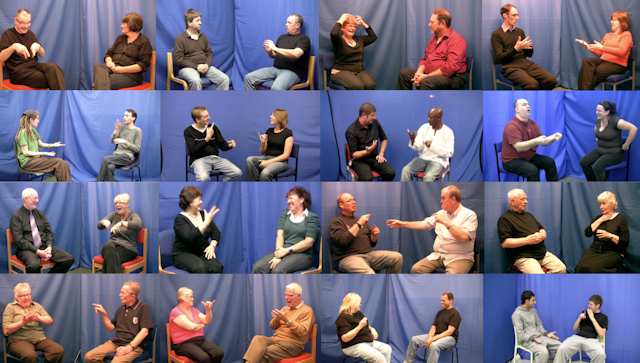There are many different ways of speaking English in the UK, with people using different regional dialects in different parts of the country. For example, some people would say “give it me” while others might say “give it to me”. There is also variation in the names given to everyday items like bread roll. Even when the same vocabulary is used, there are differences in accent – in how words are pronounced. For example, some people pronounce “foot” and “cut” so that they rhyme, while others do not.
What is perhaps much less well known is that the majority sign language of the UK’s deaf community, British Sign Language (BSL), also varies from one part of the country to another – it is clear that BSL has dialects. We do not know if BSL has regional accents (systematic differences in the pronunciation of the same signs) but research has found that deaf people from different parts of the UK use distinct regional signs for the same meanings (like the variation in words meaning “bread roll” in English mentioned above).
Many people mistakenly assume that sign language is some kind of universal form of communication. In fact, there are over 100 different sign languages in the world today. Like all natural sign languages, BSL was not invented by any single individual, but developed spontaneously.
BSL began to emerge centuries ago when deaf people gathered together to form communities across the country. As it developed separately from English, BSL has vocabulary and grammar that is different. For example, a single sign can be used to mean “I haven’t seen you in ages”. The order of signs in a question such as “what’s your name?” may be unlike typical English order too, with the question sign meaning “what” coming at the end of the sentence.
Read more: Sign languages are fully-fledged, natural languages with their own dialects – they need protecting
When modern BSL was used in the first schools for deaf children in the late 18th century, there was limited contact between the communities in various parts of the country. As a result, different signs for the same meaning emerged independently of each other - particularly in residential schools for deaf children in the 19th century, where deaf children in the playgrounds and dormitories created some of their own signs.
These signs then became part of each local regional variety of BSL. For example, the sign meaning “green” in Glasgow is different from the sign used in Cardiff. Despite the variation, however, research indicates that fluent deaf signers from different parts of the country have little trouble understanding each other.
To understand this variation better, we (a team of deaf and hearing researchers) created the BSL Corpus Project. A corpus is a collection of linguistic data, created specifically as a representative sample of a community’s language. What we created is a unique repository of the rich variation in the sign language of the British deaf community, an often overlooked but vital part of the UK’s cultural and linguistic heritage.
As it is a visual language, we used digital video to create the data. Our team filmed 249 deaf people from eight cities across the UK – London, Bristol, Birmingham, Manchester, Newcastle, Glasgow, Cardiff and Belfast. Using this footage, we analysed variation and confirmed strong regional differences in vocabulary. This was true in signs for colours – we found around 17 different signs for “purple”. Signs for the numbers one to 20 also vary a great deal, with Manchester having a number sign system unlike any other in the UK. However, we found that these traditional differences are diminishing, with younger deaf people tending to prefer more widely-used colour and number signs over local signs.
We also found that place name signs may work to show local versus non-local identities. For example, Newcastle signers tended to use a different sign to refer to their home city than others from outside Newcastle. This shows that, like regional differences in British English, variation in BSL is tied to strong feelings of local identity.
All of the regional variations we found are documented in BSL SignBank, an online BSL dictionary based on signs from the corpus. There is still so much to explore in the corpus data, so we may yet find evidence of BSL “accent” variation. If there were systematic differences in the shape of the hands, or where the hands are located or how they move, for example, then this could constitute “accent”. No such differences have yet been identified – although there might be evidence for a “late learner” accent, categorised by larger, more erratic movements, this is related to fluency and not to region.

